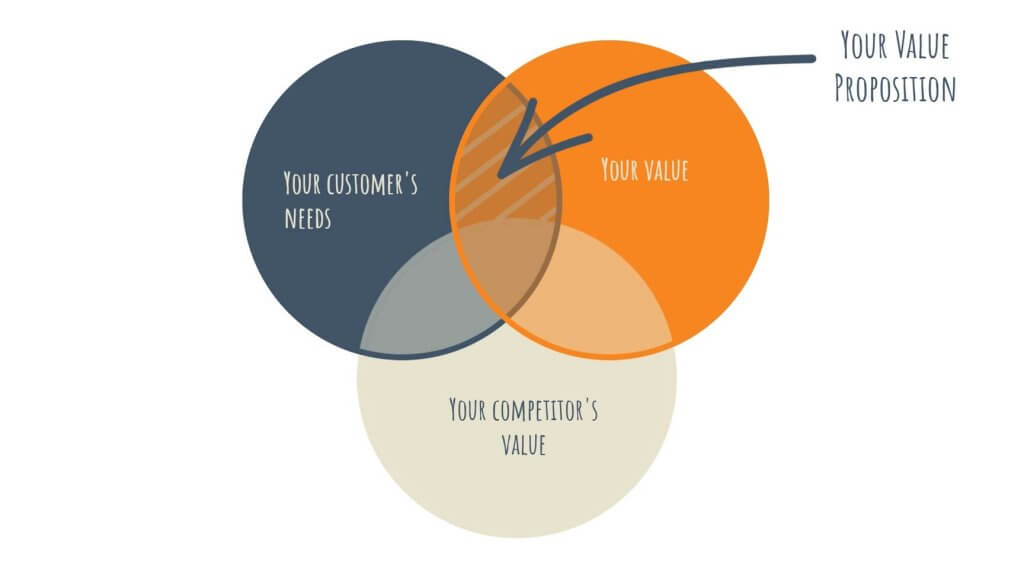Like many snazzy marketing terms, “value proposition” is a fancy way of saying something that is actually really very simple. In a nutshell, a value proposition is the reason why someone would buy your product or service.
Of course, like a lot of simple things, you sometimes need to put a good deal of thought into your value proposition(s). More on that in a bit, but first, let’s talk about why you need ‘em.
Why do you need a value proposition?
So, first, let’s be clear: we don’t care whether you call this thing we’re talking about a “value proposition”, or a “Unique Selling Proposition” or “sell point” or a “statement of value”. What it’s called, and the exact form it takes, is completely immaterial. What matters to your business is that you have, know, and can talk about a reason why people will buy from you.
I can’t tell you the number of small business owners that have looked blank when I’ve asked them why someone would buy from them rather than their competitors. It’s not something they’ve ever really thought about. But here’s the thing: if you don’t know why people would buy your product, there is no way you’re going to be able to convince people to buy it.
And marketing, at it’s very heart, is about convincing people to buy your product. It’s not enough to just put your name out in front of people, and hope they naturally “get” the value you offer.
Once you’ve developed your value proposition, you can communicate the “why” of your product in your marketing: on your website, in ads, on your social media, etc.
So, to recap: you need a value proposition so that, ultimately, people will know why they should buy a specific product (or buy from your company in general – yes, you can have a broad one for your company as well as specific ones for specific products).
How do I develop a value proposition?
There is a lot of advice out there about how to develop value propositions, including “we-hired-a-consultant-that-needs-to-earn-their-keep” methods that are totally complicated. In classic Urban Sherpa fashion, however, we’re going to stick with a more common-sense approach here.
- Identify and understand the target audience for your product or service: who will buy this product? What are their needs, fears, hopes, desires?
- Look at your competition: what does your competition sell? What do they do well, and what do they do poorly?
- Identify the features of your product or service: how does your product address the needs, fears, hopes, or desires of your audience? How is your product better than what the competition does? Why would someone pick you over them? Think about features of your product or service like price, service level, quality, your brand promise, actual physical features, appearance, selection, etc.
You’re talking about this area of intersection:
Now, put that all together into a (short) statement that addresses how your product or service meets the needs of your customers.
Before we move onto some examples, let’s talk quickly about when you should develop your value proposition(s). Ideally, you should be thinking about how your product or service best services the needs of your customer – and how you stand out from the competition – as soon as possible. Heck, it should be the first thing you think about when you start a new company or develop a new product.
Some Examples (sort of)
There are a lot of lists of “modern and creative” value propositions out there – with example after super cool, unique, and clever example. Those are fun and all, but the reality is that they don’t need to be a glitzy marketing phrase to be effective. In fact, the whole point of a value proposition is to help you identify and clearly state why customers should buy from you. Some of the examples you see out there are unfortunately so cool, they don’t actually mean as much as they should.
Our advice? Focus on putting together a solid, concise, useful, and accurate value proposition, and don’t bother worrying about how creative or cool it is. Use this work-a-day model to remind yourself about what you should be communicating – and then you can play with (and test) fancy headlines for the how you communicate it.
A good value proposition is like the foundation of a house: it’s not sexy, you normally don’t even notice it… but if it’s weak or not there the whole house will fall down.
Do you still want some examples? Try ours: Custom marketing consulting and services for the needs (and budgets) of small businesses and startups. It’s got the “who” our customer is, the “what” we offer them, and how we stand out: affordability and a specialization in small biz. Heck, “we have cold coconuts” (in the photos above) is a perfectly good value proposition as well.
Or we like the ones collected by the good folks at Oberlo: 10 Best Value Proposition Examples (and How to Create a Good One) (oberlo.com)
Of course, if you’re still stuck, we’d be glad to help you develop your value proposition(s). Reach out to us at hello@urbansherpa.marketing and we can set up a time to talk.
Happy small business marketing!
Katie & Theron

